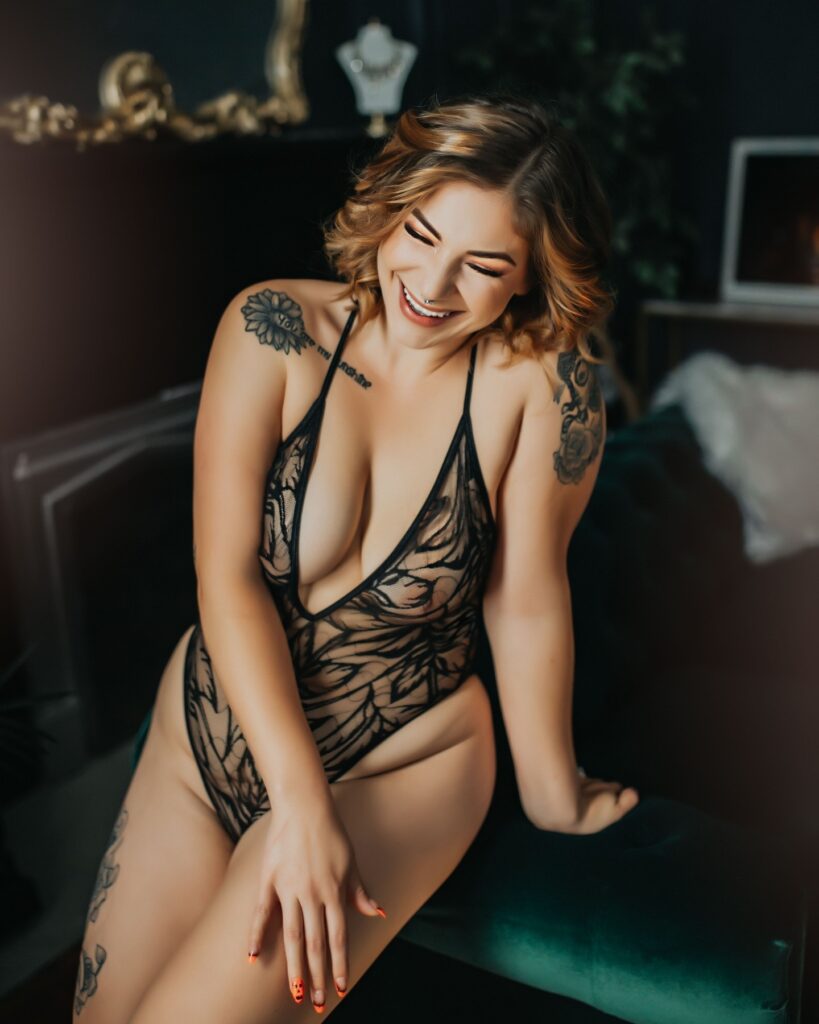Lace boudoir photography has been around for about as long as the invention of the camera in 1816. Today, many people think of lace boudoir photography surrounding bridal or wedding boudoir—but in reality, wearing lace lingerie at your next boudoir photoshoot is a timeless, classy option for any occasion. We sure love the material here at Black Lace, and we figure once you know a little bit more about it, you will too! Lace lingerie is becoming more and more popular for boudoir photoshoots because it looks sexy and elegant. In this blog post, we will discuss the history of lace, how it is made today, and why you should choose lace underwear for your next photoshoot!


What Is Lace?
Lace is a type of fabric that has been around for centuries. It is made by looping thread over itself in a pattern, and it can be used to make both clothing and lingerie. This delicate fabric is created by weaving thread or yarn in a web-like pattern.
What Are the Different Kinds of Lace?
The world of lace is vast in that there are all kinds of different styles and materials used to create lace fabric. Typically, however, lace fabrics are divided into two main categories: bobbin lace and needle lace. Needle lace is created with a single needle and thread; bobbin lace, in comparison, is made from multiple threads wound on bobbins.
There are many other kinds of lace besides bobbin and needle lace, such as crocheted lace, which is created with the use of a crochet hook. Other types of lace include:
- Knotted lace, or macramé
- Cutwork, which is the process of cutting threads from a woven backdrop and often includes embroidered embellishments
- Knitted lace
- Chemical lace, which involves a removable stitching area made of dissolvable or meltable material that may be removed to reveal the lacework
- And machine-made lace
What’s the Difference Between Lace and Embroidery?
While both the practice of embroidery and creating lace involve manipulating string to form a kind of fabric, embroidery typically adds more material to a sheet of pre-existing fabric while lace may be so fine it is nearly transparent. Lace also tends to be more elastic because of the way the threads are woven together, whereas embroidery tends to be a little less flexible. Embroidery is frequently added to the top of lace, but not the other way around.


When Was Lace Invented?
While the exact origin of lace is unknown, it is thought that the practice of creating lace was born sometime in the 13th century. Originally, lace was made from silver, gold, silk, or linen threads to create luxurious clothing, while today it is primarily made with cotton threads.
Both Flemish and Italian claims have been staked as to the origins of lace, though it is impossible to trace any surviving pieces back to a single locale. In fact, lace from the 1400s is exceedingly rare, as the delicate nature of the fabric means that it is easily damaged or worn down over time. What we do know, however, is that the Catholic church began using lace in ceremonies until eventually, northwestern Europe began adorning their clothing with lace (especially cuffs and collars) in the 1500s.
Since it became associated with status and nobility in the 16th century, lace has continued its leading role in the current fashion industry in everything from shawls and overcoats to undergarments like bras, panties, or garters. However “trendy” an article of lace clothing today might appear, lace has been a major player in the garment industry for hundreds and hundreds of years!
How Is Lace Made?
Today, most lace is made on state-of-the-art embroidering machines. However, it was originally made primarily through hand-crafted cutwork.
Will Lace Shrink In the Dryer?
If your lace is made of cotton, it will shrink in the dryer! It’s best to be gentle with your lace anyway—either tumble dry in a mesh zip-top bag on a low heat setting, or skip the dryer entirely and hand wash and air dry your lace.
If you’re interested in washing lace lingerie by hand, try using a lingerie wash specifically designed for laundering your delicates. The most important step is allowing your lace to soak in warm, soapy water before thoroughly rinsing out any detergents.
Why Lace Lingerie?
Since western Europe’s nobility first became obsessed with lace, we’ve long associated it with class and elegance—to the degree that lace garments still evoke this sensation, today. Choosing lace lingerie is not only a power move (hello, queen status!) but it is almost always flattering. If you’re still not sure what to wear to your boudoir photoshoot, contact your photographer ahead of time to see if they have a rotating closet for you to explore before your session!


Black Lace Boudoir Photography in Fredericksburg, VA
Lace boudoir photography is such a popular part of glamour and boudoir photoshoots, it could very well be its own subgenre. The reason for this is rooted in historical significance, the luxurious nature of the fabric itself, and the ornate craftsmanship that used to go into crafting lace by hand. While today it can be made by using embroidery machines, there’s no denying that the delicate nature of lace adds a little something special to your knickers and could be the element that takes your next boudoir photoshoot to the next level.
Are you interested in booking a professional photographer to turn your lace boudoir photography dreams into a reality? Contact Rami today to book a session, or click here to browse her portfolio of previous work!

